ETS5002 - Reflection on Interviews About Secondary School Experiences
VerifiedAdded on 2023/06/08
|7
|1691
|280
Report
AI Summary
This report presents a reflection on secondary school experiences gathered through student interviews. It explores the theme of group discussions as a teaching strategy, highlighting both its benefits and challenges, particularly for students with ASD or those from diverse cultural backgrounds. The interviews reveal that group discussions enhance learning, foster confidence, and demystify stereotypes, but can also disadvantage slow learners. The reflection connects these findings to education policy and teaching practices, advocating for the strategic use of group discussions in specific subjects, the creation of inclusive environments, and the provision of teacher guidance. It emphasizes the importance of pre-planning discussions and offering support to ensure all students benefit from this collaborative learning approach. Desklib provides a platform to explore more solved assignments and past papers.
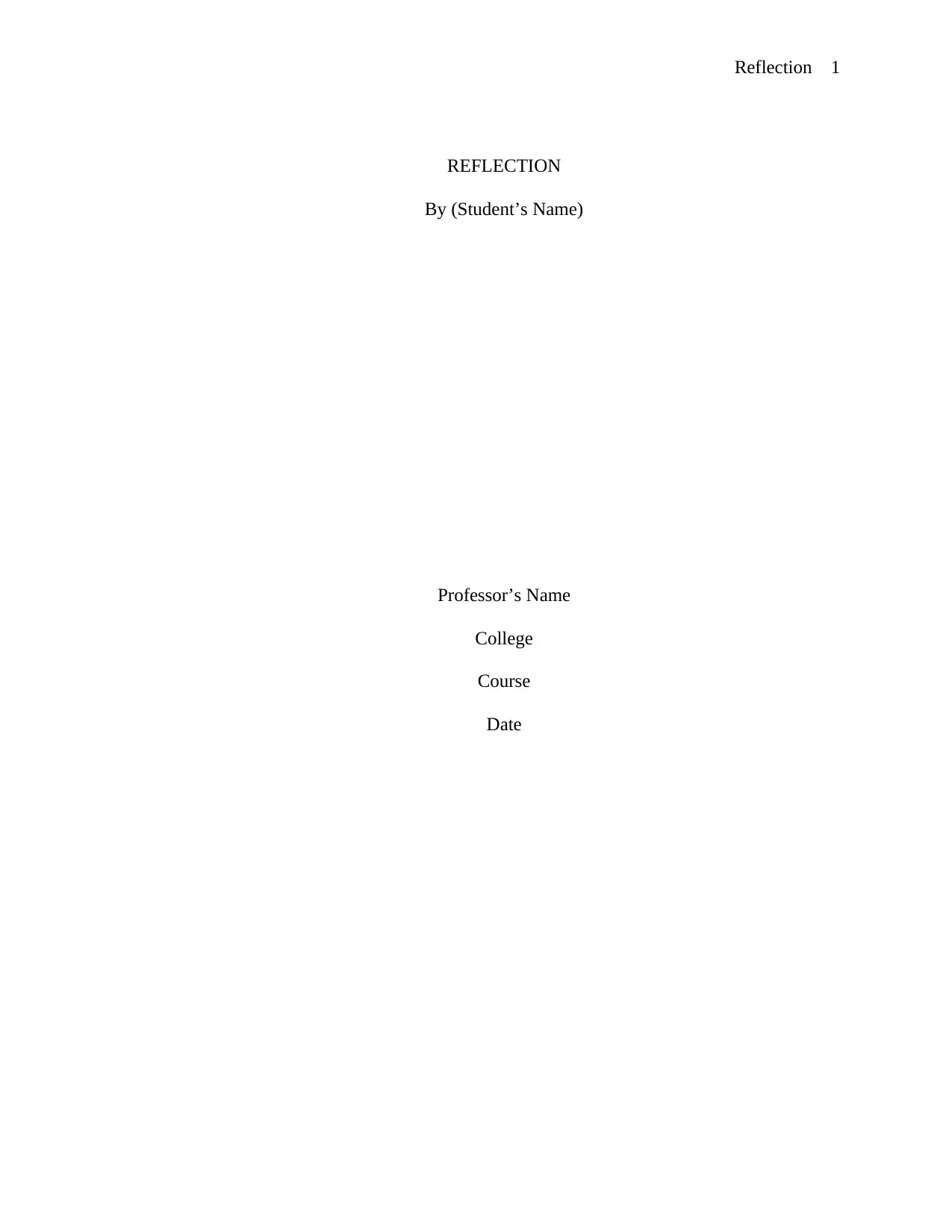
Reflection 1
REFLECTION
By (Student’s Name)
Professor’s Name
College
Course
Date
REFLECTION
By (Student’s Name)
Professor’s Name
College
Course
Date
Paraphrase This Document
Need a fresh take? Get an instant paraphrase of this document with our AI Paraphraser
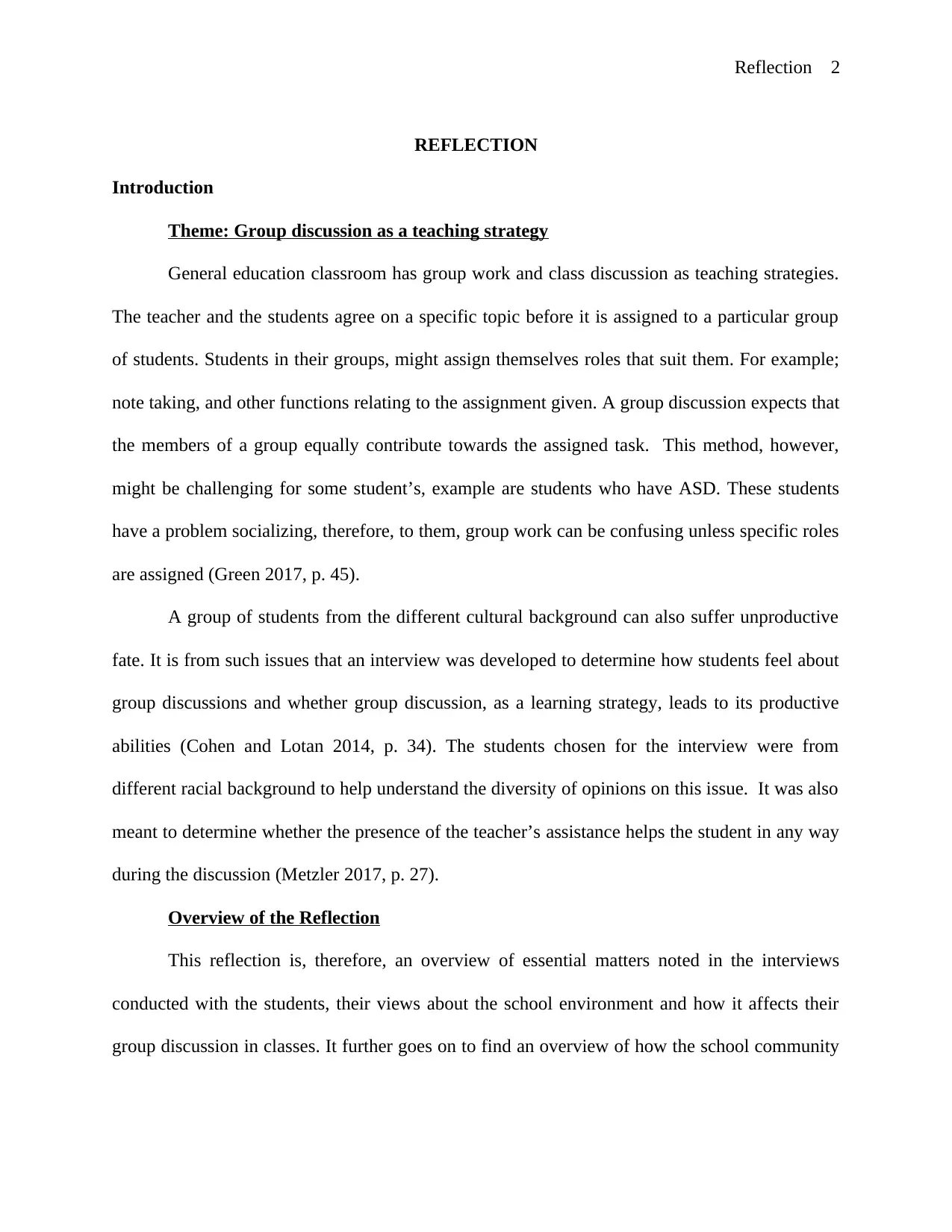
Reflection 2
REFLECTION
Introduction
Theme: Group discussion as a teaching strategy
General education classroom has group work and class discussion as teaching strategies.
The teacher and the students agree on a specific topic before it is assigned to a particular group
of students. Students in their groups, might assign themselves roles that suit them. For example;
note taking, and other functions relating to the assignment given. A group discussion expects that
the members of a group equally contribute towards the assigned task. This method, however,
might be challenging for some student’s, example are students who have ASD. These students
have a problem socializing, therefore, to them, group work can be confusing unless specific roles
are assigned (Green 2017, p. 45).
A group of students from the different cultural background can also suffer unproductive
fate. It is from such issues that an interview was developed to determine how students feel about
group discussions and whether group discussion, as a learning strategy, leads to its productive
abilities (Cohen and Lotan 2014, p. 34). The students chosen for the interview were from
different racial background to help understand the diversity of opinions on this issue. It was also
meant to determine whether the presence of the teacher’s assistance helps the student in any way
during the discussion (Metzler 2017, p. 27).
Overview of the Reflection
This reflection is, therefore, an overview of essential matters noted in the interviews
conducted with the students, their views about the school environment and how it affects their
group discussion in classes. It further goes on to find an overview of how the school community
REFLECTION
Introduction
Theme: Group discussion as a teaching strategy
General education classroom has group work and class discussion as teaching strategies.
The teacher and the students agree on a specific topic before it is assigned to a particular group
of students. Students in their groups, might assign themselves roles that suit them. For example;
note taking, and other functions relating to the assignment given. A group discussion expects that
the members of a group equally contribute towards the assigned task. This method, however,
might be challenging for some student’s, example are students who have ASD. These students
have a problem socializing, therefore, to them, group work can be confusing unless specific roles
are assigned (Green 2017, p. 45).
A group of students from the different cultural background can also suffer unproductive
fate. It is from such issues that an interview was developed to determine how students feel about
group discussions and whether group discussion, as a learning strategy, leads to its productive
abilities (Cohen and Lotan 2014, p. 34). The students chosen for the interview were from
different racial background to help understand the diversity of opinions on this issue. It was also
meant to determine whether the presence of the teacher’s assistance helps the student in any way
during the discussion (Metzler 2017, p. 27).
Overview of the Reflection
This reflection is, therefore, an overview of essential matters noted in the interviews
conducted with the students, their views about the school environment and how it affects their
group discussion in classes. It further goes on to find an overview of how the school community
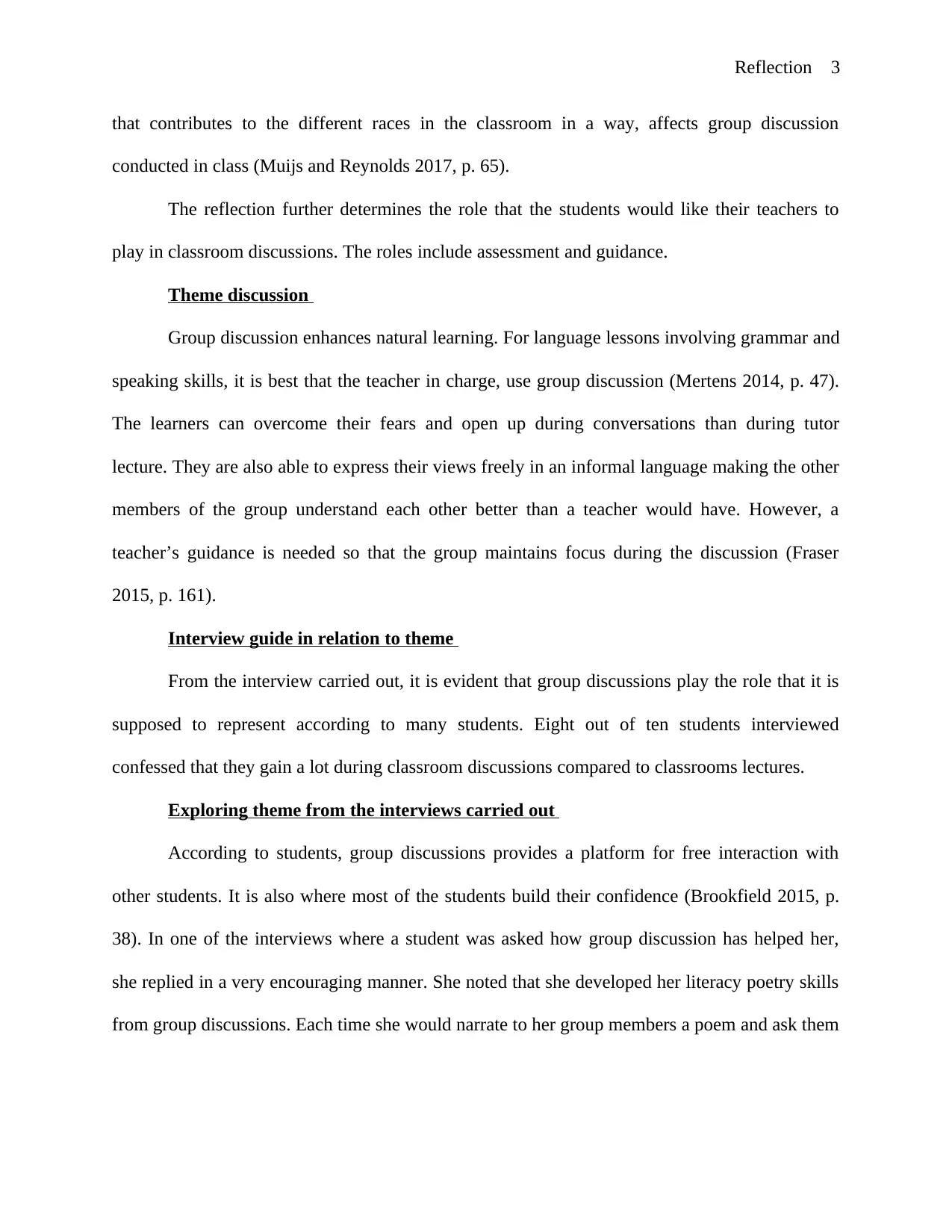
Reflection 3
that contributes to the different races in the classroom in a way, affects group discussion
conducted in class (Muijs and Reynolds 2017, p. 65).
The reflection further determines the role that the students would like their teachers to
play in classroom discussions. The roles include assessment and guidance.
Theme discussion
Group discussion enhances natural learning. For language lessons involving grammar and
speaking skills, it is best that the teacher in charge, use group discussion (Mertens 2014, p. 47).
The learners can overcome their fears and open up during conversations than during tutor
lecture. They are also able to express their views freely in an informal language making the other
members of the group understand each other better than a teacher would have. However, a
teacher’s guidance is needed so that the group maintains focus during the discussion (Fraser
2015, p. 161).
Interview guide in relation to theme
From the interview carried out, it is evident that group discussions play the role that it is
supposed to represent according to many students. Eight out of ten students interviewed
confessed that they gain a lot during classroom discussions compared to classrooms lectures.
Exploring theme from the interviews carried out
According to students, group discussions provides a platform for free interaction with
other students. It is also where most of the students build their confidence (Brookfield 2015, p.
38). In one of the interviews where a student was asked how group discussion has helped her,
she replied in a very encouraging manner. She noted that she developed her literacy poetry skills
from group discussions. Each time she would narrate to her group members a poem and ask them
that contributes to the different races in the classroom in a way, affects group discussion
conducted in class (Muijs and Reynolds 2017, p. 65).
The reflection further determines the role that the students would like their teachers to
play in classroom discussions. The roles include assessment and guidance.
Theme discussion
Group discussion enhances natural learning. For language lessons involving grammar and
speaking skills, it is best that the teacher in charge, use group discussion (Mertens 2014, p. 47).
The learners can overcome their fears and open up during conversations than during tutor
lecture. They are also able to express their views freely in an informal language making the other
members of the group understand each other better than a teacher would have. However, a
teacher’s guidance is needed so that the group maintains focus during the discussion (Fraser
2015, p. 161).
Interview guide in relation to theme
From the interview carried out, it is evident that group discussions play the role that it is
supposed to represent according to many students. Eight out of ten students interviewed
confessed that they gain a lot during classroom discussions compared to classrooms lectures.
Exploring theme from the interviews carried out
According to students, group discussions provides a platform for free interaction with
other students. It is also where most of the students build their confidence (Brookfield 2015, p.
38). In one of the interviews where a student was asked how group discussion has helped her,
she replied in a very encouraging manner. She noted that she developed her literacy poetry skills
from group discussions. Each time she would narrate to her group members a poem and ask them
⊘ This is a preview!⊘
Do you want full access?
Subscribe today to unlock all pages.

Trusted by 1+ million students worldwide
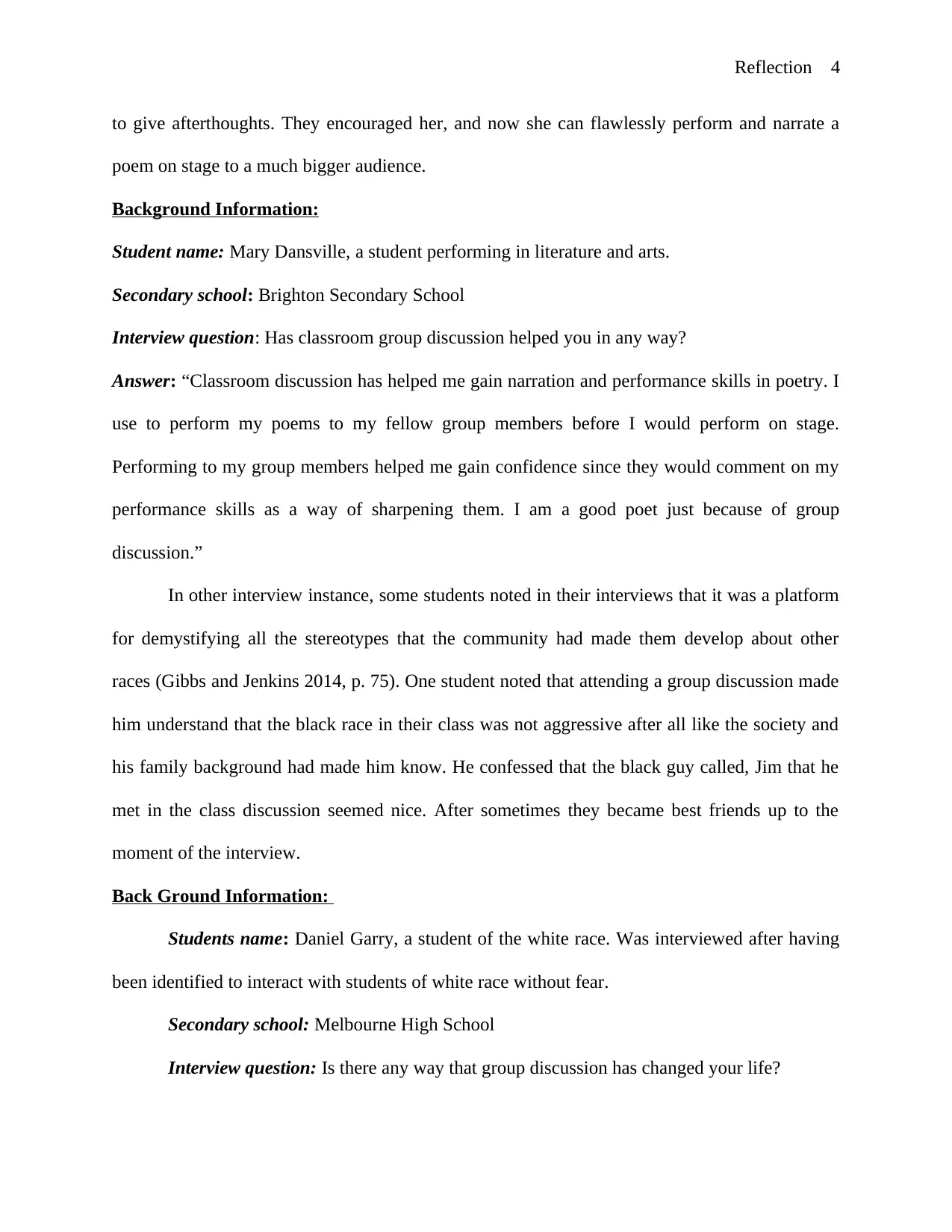
Reflection 4
to give afterthoughts. They encouraged her, and now she can flawlessly perform and narrate a
poem on stage to a much bigger audience.
Background Information:
Student name: Mary Dansville, a student performing in literature and arts.
Secondary school: Brighton Secondary School
Interview question: Has classroom group discussion helped you in any way?
Answer: “Classroom discussion has helped me gain narration and performance skills in poetry. I
use to perform my poems to my fellow group members before I would perform on stage.
Performing to my group members helped me gain confidence since they would comment on my
performance skills as a way of sharpening them. I am a good poet just because of group
discussion.”
In other interview instance, some students noted in their interviews that it was a platform
for demystifying all the stereotypes that the community had made them develop about other
races (Gibbs and Jenkins 2014, p. 75). One student noted that attending a group discussion made
him understand that the black race in their class was not aggressive after all like the society and
his family background had made him know. He confessed that the black guy called, Jim that he
met in the class discussion seemed nice. After sometimes they became best friends up to the
moment of the interview.
Back Ground Information:
Students name: Daniel Garry, a student of the white race. Was interviewed after having
been identified to interact with students of white race without fear.
Secondary school: Melbourne High School
Interview question: Is there any way that group discussion has changed your life?
to give afterthoughts. They encouraged her, and now she can flawlessly perform and narrate a
poem on stage to a much bigger audience.
Background Information:
Student name: Mary Dansville, a student performing in literature and arts.
Secondary school: Brighton Secondary School
Interview question: Has classroom group discussion helped you in any way?
Answer: “Classroom discussion has helped me gain narration and performance skills in poetry. I
use to perform my poems to my fellow group members before I would perform on stage.
Performing to my group members helped me gain confidence since they would comment on my
performance skills as a way of sharpening them. I am a good poet just because of group
discussion.”
In other interview instance, some students noted in their interviews that it was a platform
for demystifying all the stereotypes that the community had made them develop about other
races (Gibbs and Jenkins 2014, p. 75). One student noted that attending a group discussion made
him understand that the black race in their class was not aggressive after all like the society and
his family background had made him know. He confessed that the black guy called, Jim that he
met in the class discussion seemed nice. After sometimes they became best friends up to the
moment of the interview.
Back Ground Information:
Students name: Daniel Garry, a student of the white race. Was interviewed after having
been identified to interact with students of white race without fear.
Secondary school: Melbourne High School
Interview question: Is there any way that group discussion has changed your life?
Paraphrase This Document
Need a fresh take? Get an instant paraphrase of this document with our AI Paraphraser
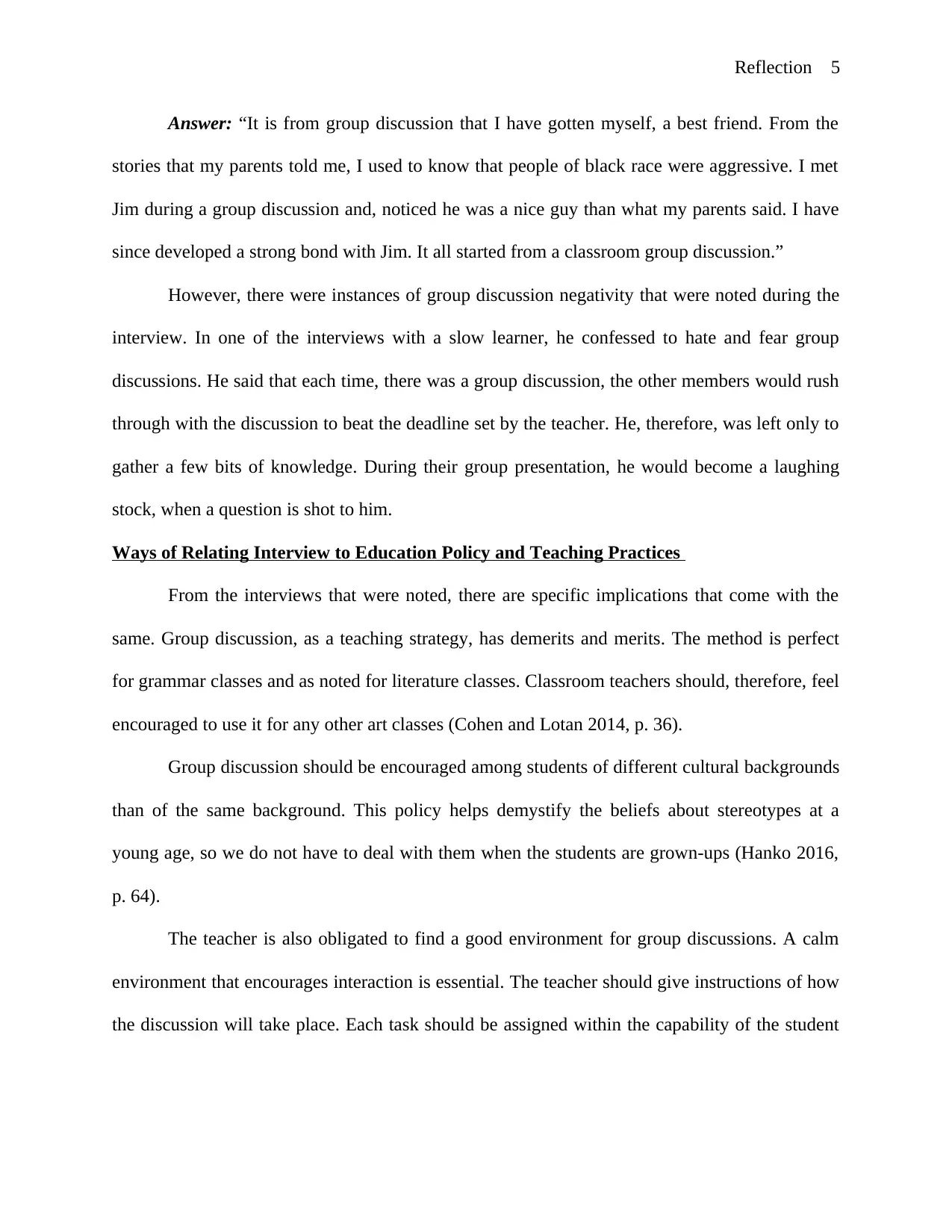
Reflection 5
Answer: “It is from group discussion that I have gotten myself, a best friend. From the
stories that my parents told me, I used to know that people of black race were aggressive. I met
Jim during a group discussion and, noticed he was a nice guy than what my parents said. I have
since developed a strong bond with Jim. It all started from a classroom group discussion.”
However, there were instances of group discussion negativity that were noted during the
interview. In one of the interviews with a slow learner, he confessed to hate and fear group
discussions. He said that each time, there was a group discussion, the other members would rush
through with the discussion to beat the deadline set by the teacher. He, therefore, was left only to
gather a few bits of knowledge. During their group presentation, he would become a laughing
stock, when a question is shot to him.
Ways of Relating Interview to Education Policy and Teaching Practices
From the interviews that were noted, there are specific implications that come with the
same. Group discussion, as a teaching strategy, has demerits and merits. The method is perfect
for grammar classes and as noted for literature classes. Classroom teachers should, therefore, feel
encouraged to use it for any other art classes (Cohen and Lotan 2014, p. 36).
Group discussion should be encouraged among students of different cultural backgrounds
than of the same background. This policy helps demystify the beliefs about stereotypes at a
young age, so we do not have to deal with them when the students are grown-ups (Hanko 2016,
p. 64).
The teacher is also obligated to find a good environment for group discussions. A calm
environment that encourages interaction is essential. The teacher should give instructions of how
the discussion will take place. Each task should be assigned within the capability of the student
Answer: “It is from group discussion that I have gotten myself, a best friend. From the
stories that my parents told me, I used to know that people of black race were aggressive. I met
Jim during a group discussion and, noticed he was a nice guy than what my parents said. I have
since developed a strong bond with Jim. It all started from a classroom group discussion.”
However, there were instances of group discussion negativity that were noted during the
interview. In one of the interviews with a slow learner, he confessed to hate and fear group
discussions. He said that each time, there was a group discussion, the other members would rush
through with the discussion to beat the deadline set by the teacher. He, therefore, was left only to
gather a few bits of knowledge. During their group presentation, he would become a laughing
stock, when a question is shot to him.
Ways of Relating Interview to Education Policy and Teaching Practices
From the interviews that were noted, there are specific implications that come with the
same. Group discussion, as a teaching strategy, has demerits and merits. The method is perfect
for grammar classes and as noted for literature classes. Classroom teachers should, therefore, feel
encouraged to use it for any other art classes (Cohen and Lotan 2014, p. 36).
Group discussion should be encouraged among students of different cultural backgrounds
than of the same background. This policy helps demystify the beliefs about stereotypes at a
young age, so we do not have to deal with them when the students are grown-ups (Hanko 2016,
p. 64).
The teacher is also obligated to find a good environment for group discussions. A calm
environment that encourages interaction is essential. The teacher should give instructions of how
the discussion will take place. Each task should be assigned within the capability of the student
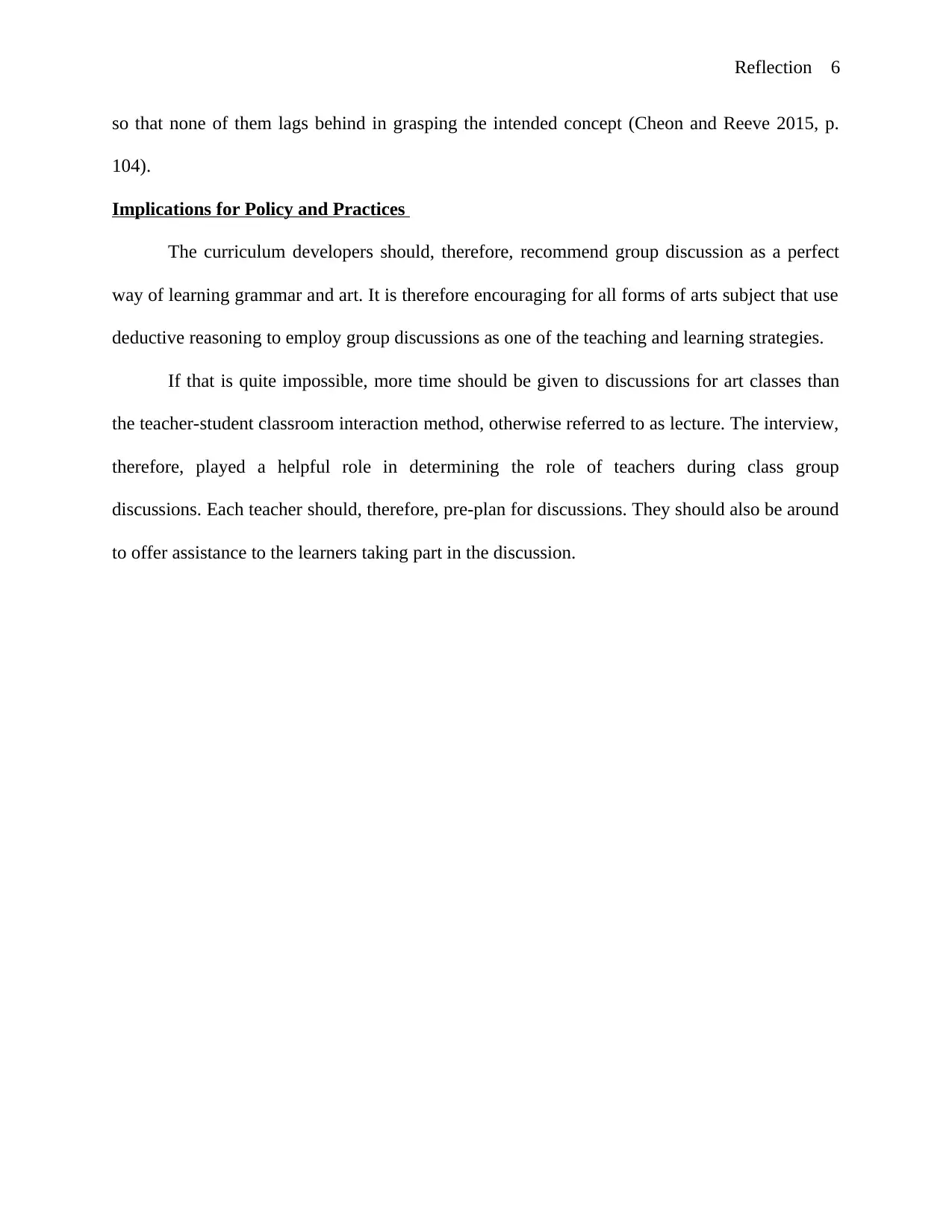
Reflection 6
so that none of them lags behind in grasping the intended concept (Cheon and Reeve 2015, p.
104).
Implications for Policy and Practices
The curriculum developers should, therefore, recommend group discussion as a perfect
way of learning grammar and art. It is therefore encouraging for all forms of arts subject that use
deductive reasoning to employ group discussions as one of the teaching and learning strategies.
If that is quite impossible, more time should be given to discussions for art classes than
the teacher-student classroom interaction method, otherwise referred to as lecture. The interview,
therefore, played a helpful role in determining the role of teachers during class group
discussions. Each teacher should, therefore, pre-plan for discussions. They should also be around
to offer assistance to the learners taking part in the discussion.
so that none of them lags behind in grasping the intended concept (Cheon and Reeve 2015, p.
104).
Implications for Policy and Practices
The curriculum developers should, therefore, recommend group discussion as a perfect
way of learning grammar and art. It is therefore encouraging for all forms of arts subject that use
deductive reasoning to employ group discussions as one of the teaching and learning strategies.
If that is quite impossible, more time should be given to discussions for art classes than
the teacher-student classroom interaction method, otherwise referred to as lecture. The interview,
therefore, played a helpful role in determining the role of teachers during class group
discussions. Each teacher should, therefore, pre-plan for discussions. They should also be around
to offer assistance to the learners taking part in the discussion.
⊘ This is a preview!⊘
Do you want full access?
Subscribe today to unlock all pages.

Trusted by 1+ million students worldwide
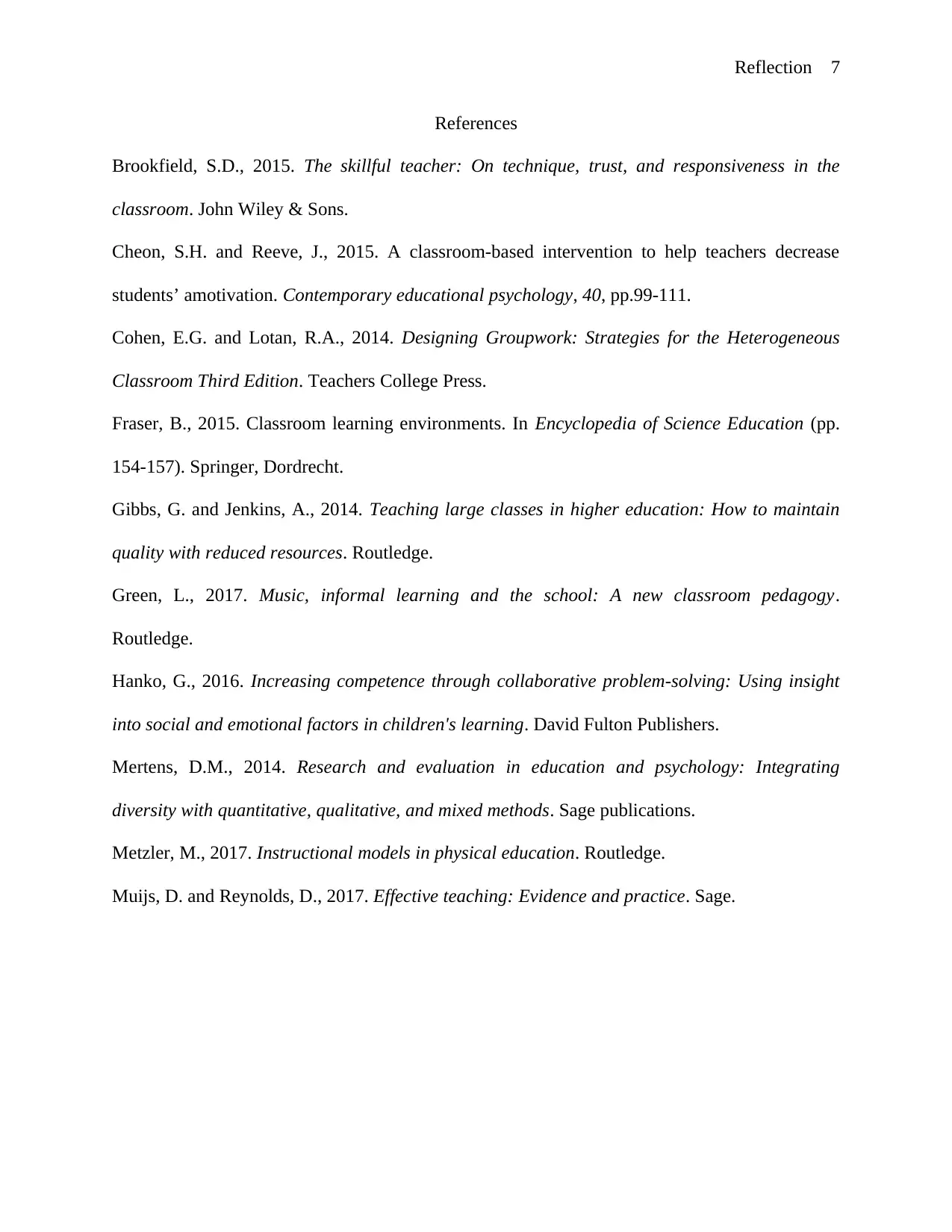
Reflection 7
References
Brookfield, S.D., 2015. The skillful teacher: On technique, trust, and responsiveness in the
classroom. John Wiley & Sons.
Cheon, S.H. and Reeve, J., 2015. A classroom-based intervention to help teachers decrease
students’ amotivation. Contemporary educational psychology, 40, pp.99-111.
Cohen, E.G. and Lotan, R.A., 2014. Designing Groupwork: Strategies for the Heterogeneous
Classroom Third Edition. Teachers College Press.
Fraser, B., 2015. Classroom learning environments. In Encyclopedia of Science Education (pp.
154-157). Springer, Dordrecht.
Gibbs, G. and Jenkins, A., 2014. Teaching large classes in higher education: How to maintain
quality with reduced resources. Routledge.
Green, L., 2017. Music, informal learning and the school: A new classroom pedagogy.
Routledge.
Hanko, G., 2016. Increasing competence through collaborative problem-solving: Using insight
into social and emotional factors in children's learning. David Fulton Publishers.
Mertens, D.M., 2014. Research and evaluation in education and psychology: Integrating
diversity with quantitative, qualitative, and mixed methods. Sage publications.
Metzler, M., 2017. Instructional models in physical education. Routledge.
Muijs, D. and Reynolds, D., 2017. Effective teaching: Evidence and practice. Sage.
References
Brookfield, S.D., 2015. The skillful teacher: On technique, trust, and responsiveness in the
classroom. John Wiley & Sons.
Cheon, S.H. and Reeve, J., 2015. A classroom-based intervention to help teachers decrease
students’ amotivation. Contemporary educational psychology, 40, pp.99-111.
Cohen, E.G. and Lotan, R.A., 2014. Designing Groupwork: Strategies for the Heterogeneous
Classroom Third Edition. Teachers College Press.
Fraser, B., 2015. Classroom learning environments. In Encyclopedia of Science Education (pp.
154-157). Springer, Dordrecht.
Gibbs, G. and Jenkins, A., 2014. Teaching large classes in higher education: How to maintain
quality with reduced resources. Routledge.
Green, L., 2017. Music, informal learning and the school: A new classroom pedagogy.
Routledge.
Hanko, G., 2016. Increasing competence through collaborative problem-solving: Using insight
into social and emotional factors in children's learning. David Fulton Publishers.
Mertens, D.M., 2014. Research and evaluation in education and psychology: Integrating
diversity with quantitative, qualitative, and mixed methods. Sage publications.
Metzler, M., 2017. Instructional models in physical education. Routledge.
Muijs, D. and Reynolds, D., 2017. Effective teaching: Evidence and practice. Sage.
1 out of 7
Related Documents
Your All-in-One AI-Powered Toolkit for Academic Success.
+13062052269
info@desklib.com
Available 24*7 on WhatsApp / Email
![[object Object]](/_next/static/media/star-bottom.7253800d.svg)
Unlock your academic potential
Copyright © 2020–2025 A2Z Services. All Rights Reserved. Developed and managed by ZUCOL.





